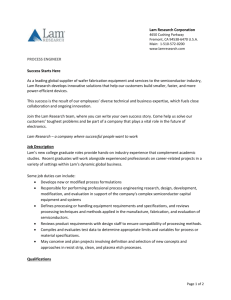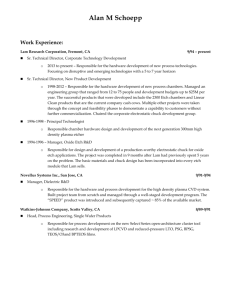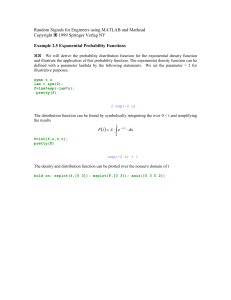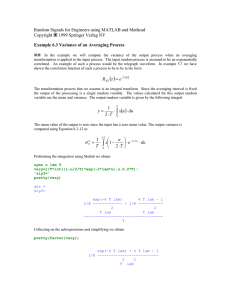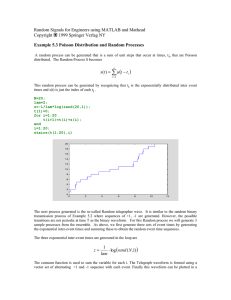The 450 mm Transition: An Equipment Supplier`s
advertisement
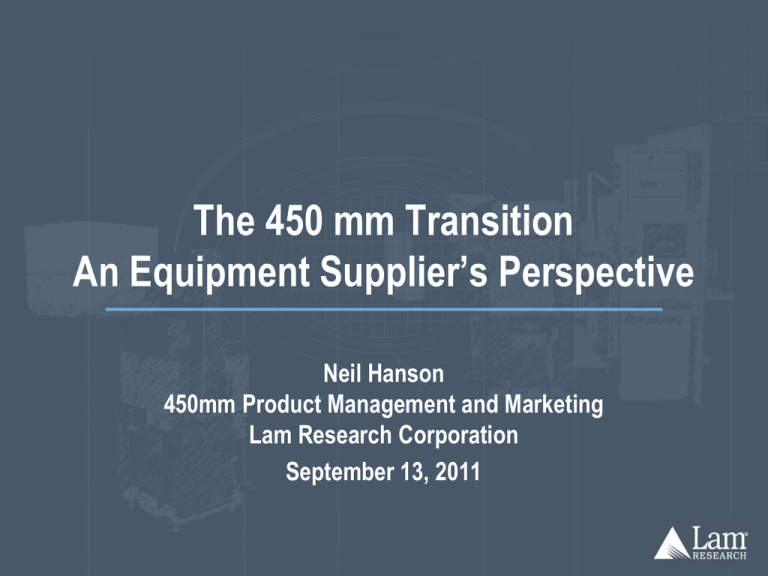
The 450 mm Transition An Equipment Supplier’s Perspective Neil Hanson 450mm Product Management and Marketing Lam Research Corporation September 13, 2011 Agenda (v7) Lam Research Overview 450mm - timing questions and implications 450mm – etch scaling Summary and further questions Slide - 2 Lam Research Corporation – Sematech Symposium Taiwan 2011 Lam Research at a Glance Major supplier of wafer fab equipment and services – Headquartered in Fremont, California, with facilities in Asia, Europe, and North America – ~3,650 Employees worldwide – Revenue of $3.24B in the last four quarters Etch and Clean product lines offer leading technologies for performance and extendibility – Conductor, dielectric, MEMS, deep silicon, and through-silicon via (TSV) etch – Wet and plasma-based single-wafer clean (v7) Customer Support Business Group (CSBG) dedicated to optimizing installed equipment performance and operational efficiency Slide - 3 Lam Research Corporation – Sematech Symposium Taiwan 2011 Lam Research Global Support – Close to Our Customers Northwest Idaho, Washington Germany Northeast Dresden New York Switzerland France Corp. Headquarters Arizona, Texas Beijing, Shanghai, Wuhan, Wuxi Schiphol-Rijk Dublin Central China The Netherlands Ireland Corbeil Essonnes, Meylan, Rousset Neuchatel Italy Agrate Japan Hiroshima, Kumamoto, Shin-Yokohama, Toyama, Yokkaichi Austria Villach Israel Korea: Ramat Gan Malaysia Fremont, CA Livermore, CA Bundang, Cheongju, Hwaseong, Icheon Taiwan Singapore (v7) Slide - 4 Lam Research Corporation – Sematech Symposium Taiwan 2011 Gueishan, Houli, Hsinchu, Tainan Lam Research Product & Technology Milestones 1981 1987 1988 First product, AutoEtch Rainbow® Etch Series SEZ® spin technology for single-wafer clean 1992 1993 Alliance® cluster tool platform for etch Slide - 5 2000 2003 2004 2006 2007 2008 DV-Prime® next-generation spin clean system 2300® platform offering first 200 mm/300 mm capability 2300® Coronus® plasma bevel clean system Da Vinci® spin clean platform First product with Dual Frequency Confined™ technology for dielectric etch First Transformer Coupled Plasma™ based products for silicon and metal etch (v7) 1995 2300® Syndion® system, first 300 mm TSV etch C3® linear wet clean technology 2300® Exelan® Flex™ & 2300® Versys® Kiyo® products for dielectric & conductor etch Lam Research Corporation – Sematech Symposium Taiwan 2011 2009 2010 Shipped 7,500th etch process module for the 2300® platform Shipped 3,000th single-wafer spin clean process module 2300® Kiyo® C Series next-generation conductor etch system 2300® Flex™ D Series next-generation dielectric etch system Lam Research Ranking – Wafer Fab Equipment Revenues Rank 2006 2007 2008 2009 2010 1 Applied Materials Applied Materials Applied Materials Applied Materials Applied Materials 2 Tokyo Electron Tokyo Electron ASML ASML ASML 3 ASML ASML Tokyo Electron Tokyo Electron Tokyo Electron 4 KLA-Tencor KLA-Tencor KLA-Tencor KLA-Tencor Lam Research 5 Lam Research Lam Research Lam Research* Lam Research KLA-Tencor 6 Nikon Nikon Nikon Nikon Dainippon Screen 7 Novellus Systems Novellus Systems Dainippon Screen Dainippon Screen Nikon 8 Dainippon Screen Dainippon Screen Hitachi High-Tech Novellus Systems Novellus Systems 9 Canon Hitachi High-Tech Novellus Systems Aixtron Aixtron 10 Hitachi High-Tech Varian Canon Hitachi High-Tech Varian * Includes SEZ AG, acquired 2008 Source: Gartner Dataquest (v7) Slide - 6 Lam Research Corporation – Sematech Symposium Taiwan 2011 The Timing Question As “traditional” scaling becomes more difficult and costly, a wafer size transition becomes inevitable For 450 mm, the transition has started The big questions are: “How much will the transition cost?” “How quickly can and will the transition occur?” (v7) Slide - 7 Lam Research Corporation – Sematech Symposium Taiwan 2011 The Cost Implications of Timing – Equipment Development Equipment Supplier Preference Investment $ (Arbitrary Scale) 100 10 1 Initial Pilot (α) Basic Capability Full Pilot (β) Initial Production (ϒ) in Quantity Full Capability Time (v7) Slide - 8 Lam Research Corporation – Sematech Symposium Taiwan 2011 The Cost Implications of Timing – Equipment Development Semiconductor Manufacturer Preference Investment $ (Arbitrary Scale) 100 10 1 Initial Pilot (α) Basic Capability Full Pilot (β) Initial Production (ϒ) in Quantity Full Capability Time (v7) Slide - 9 Lam Research Corporation – Sematech Symposium Taiwan 2011 The Cost Implications of Timing – the Investment Disconnect Investment $ (Arbitrary Scale) 100 10 1 Initial Pilot (α) Basic Capability Full Pilot (β) Initial Production (ϒ) in Quantity Full Capability Time (v7) Slide - 10 Lam Research Corporation – Sematech Symposium Taiwan 2011 The Cost Implications of Timing – Timing Pushout Investment $ (Arbitrary Scale) 100 10 1 Initial Pilot (α) Basic Capability Full Pilot (β) Full Capability Time (v7) Slide - 11 Lam Research Corporation – Sematech Symposium Taiwan 2011 Initial Production (ϒ) in Quantity The Cost Implications of Timing – Timing Pushout Investment $ (Arbitrary Scale) 100 Cost Savings 10 Additional Cost 1 Initial Pilot (α) Basic Capability Full Pilot (β) Full Capability Time (v7) Slide - 12 Lam Research Corporation – Sematech Symposium Taiwan 2011 Initial Production (ϒ) in Quantity The Cost Implications of Timing – Mitigating The Disconnect Investment $ (Arbitrary Scale) 100 10 Reduced Disconnect 1 Initial Pilot (α) Virtual Fab (α) Basic Capability Basic Capability Full Pilot (β) Initial Production (ϒ) in Quantity Full Capability Time (v7) Slide - 13 Lam Research Corporation – Sematech Symposium Taiwan 2011 The Cost Implications of Timing – Mitigating The Disconnect 100 Milestone pushed out Investment $ (Arbitrary Scale) Close partnership can reduce these disconnects and timing uncertainties Milestone pushed out 10 Reduced Disconnect 1 Initial Pilot (α) Virtual Fab (α) Basic Capability Basic Capability Full Pilot (β) Initial Production (ϒ) in Quantity Full Capability Time (v7) Slide - 14 Lam Research Corporation – Sematech Symposium Taiwan 2011 Cost Benefits of a Wafer Size Transition Lessons Learned from 200 mm to 300 mm Transition The industry realized additional productivity benefits beyond ~2X greater die/wafer when transitioning from 200 mm to 300 mm (e.g., reliability, automation, utilization, WPH, speed to delivery, ramp and yield…) 450 mm has potentially less performance upside in the non-wafer size related areas Uptime & Availability (%) – Reaching an asymptote for many parameters: uptime, availability, yield, … – Less room for improvement 100 90 80 70 200 mm 300 mm Wafer Size (v7) Slide - 15 Lam Research Corporation – Sematech Symposium Taiwan 2011 450 mm Potential Equipment Scaling Issues – Example Scaling of plasma tools (etch, CVD, PVD, plasma implant, …) is “straightforward”, but there are cost implications – Plasma and gas densities scale with chamber volume not wafer radius – Plasma flux scales with the wafer area – At best, it will be an x2 increase with a simple scale-up – at worst an x3 increase • Applies to power generators and vacuum pumps Plasma Density Loss of Plasma density Scale only wafer area Scale chamber volume 300 mm Chamber Baseline (v7) Slide - 16 450 mm Chamber Baseline Increasing Chamber Volume Lam Research Corporation – Sematech Symposium Taiwan 2011 Equipment Scaling Issues – RF Power and Pumping Not only do the amount of RF power and pumping required for 450 mm increase non-linearly, but the incremental cost for that additional capability also increases non-linearly RF generator $/W increases non-linearly with higher power Turbo pump $/cfm show similar behavior with higher flows These costs will likely come down over time Cost / RF Watt RF generator cost delta for 450 mm Total Power Required (v7) Slide - 17 300 mm Lam Research Corporation – Sematech Symposium Taiwan 2011 450 mm Summary As a leading equipment supplier, we will have 450 mm equipment sets ready when our customers need them A close partnership between customers and suppliers is needed to continually understand requirements and timing to allow for appropriate investment levels Many additional questions will need to be answered during the equipment development phase: What will the 450 mm adoption rate be for Logic, Foundry, and Memory? Will there be a need for leading-edge equipment at both 450 mm and 300 mm simultaneously? Will EUV come before or after 450 mm? How will the economics (tool cost, yield and productivity improvements, automation benefits, …) of this transition compare to previous transitions? (v7) Slide - 18 Lam Research Corporation – Sematech Symposium Taiwan 2011
